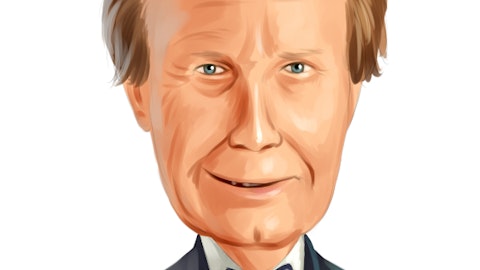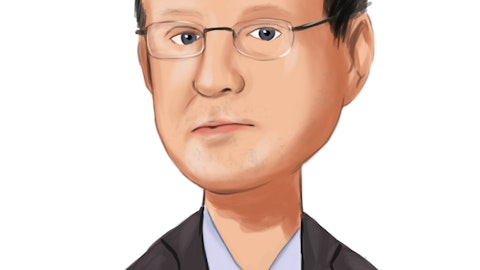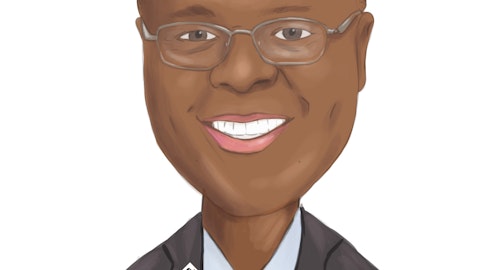Camden National Corporation (NASDAQ:CAC) Q1 2023 Earnings Call Transcript April 25, 2023
Camden National Corporation misses on earnings expectations. Reported EPS is $0.87 EPS, expectations were $0.9.
Operator: Good day, and welcome to Camden National Corporation’s First Quarter 2023 Earnings Conference Call. My name is Danielle, and I will be your operator for today’s call. All participants will be in a listen-only mode during today’s presentation. Following the presentation, we will conduct a question-and-answer session. Please note that this presentation contains forward-looking statements, which involve significant risks and uncertainties that may cause actual results to vary materially from the projected in the forward-looking statements. Additional information concerning factors that could cause actual results to differ materially from those in such forward-looking statements are described in the company’s earnings press release and supplemental earnings material, the company’s 2022 annual report on Form 10-K and other filings with the SEC.
The company does not undertake any obligation to update any forward-looking statements to reflect circumstances or events that occur after forward-looking statements are made. Any references in today’s presentation to non-GAAP financial measures are intended to provide meaningful insight and are reconciled with GAAP in your press release. Today’s presenters are Greg Dufour, President and Chief Executive Officer; and Mike Archer, Executive Vice President and Chief Financial Officer. Please note that this event is being recorded. At this time, I would like to turn the conference over to Greg Dufour. Please go ahead, sir.
Greg Dufour: Thank you, Danielle and welcome to Camden National Corporation’s first quarter 2023 earnings call. Before I turn the discussion over to Mike, I’d like to make a few opening comments. We reported net income of $12.7 million or $0.87 per diluted share for the first quarter of 2023, a 17% decrease from the fourth quarter of 2022. This resulted in a return on average equity of 11.16% and a return on tangible capital of 14.21%. Driving these results were the impact of our normal seasonal deposit outflows, overall interest rate volatility and market-based pricing increases in flattening deposit rates. We also recorded a $1.8 million pretax loss on a subordinated bond we held in Signature Bank, which was recorded – I am sorry, which was held in our held to maturity portfolio, and that loss was recorded in our provision for credit losses line.
We’ve reviewed our investment portfolio and feel comfortable with the positions we hold with only 3% in corporate bonds. Mike will speak to our investment portfolio in more detail in just a few minutes. The turmoil in the banking sector during the past quarter is sharper not focused but hasn’t drastically altered. Our priorities remain the same: deposits, margin and asset quality. Over the past several quarters, I’ve shared our strategies to leverage our retail franchise through sales management and training, outlined the investments we’ve made in corporate treasury management. And just last quarter, I shared our view regarding loan pricing. Our asset quality continues to be strong, and it starts with a strong credit culture and maintaining underwriting standards through all cycles.
Lending continues to be important to us, and we’ll continue to lend in the current environment, but will do so with a focus on maximizing our margins. We have the capacity to lend, but we will be selective as the interest rate environment and the need to focus on margins are expected to temper our loan growth in the near term. With that said, we ended the first quarter of 2023 with $4.1 billion of loans, up 2% from the end of 2022 with overall loan yields increasing 29 basis points from December. We ended the first quarter of 2023 with just over $4.4 billion of deposits, excluding broker deposits, which is 5% less than balances at the end of 2022. Further adjusting for one large municipal depositor relationship that is discussed in our earnings release, deposit balances were down only 2% from year-end.
We believe these results reflect the seasonality with a deposit base during the winter months and indicate our core customer deposit base has remained solid during the past few months. During the quarter, we also declared a dividend of $0.42 per share and did not repurchase shares during the quarter. I will now turn the discussion over to Mike.
Mike Archer: Thank you, Greg, and good afternoon, everyone. Earlier today, we reported our quarterly earnings, which included our normal earnings release as well as a supplemental deck that provides additional information to the investor community that we believe is helpful and relevant given recent events in the banking industry. This supplemental information addresses deposits, liquidity, investments and loans in more detail than normally we provide in our earnings release. I’ll speak to the Selin point of each in more detail shortly, but before I do, I want to share that Camden National’s financial footing remains strong based on firm fundamentals supported by a diverse deposit base, excellent asset quality that starts with our lenders and underwriters and strong capital levels.
As of March 31, the company’s uninsured and uncollateralized deposits were 15% of total deposits compared to 16% as of December 31, 2022. This level of uninsured uncollateralized deposits speaks to the diversification of our customer base with approximately 70% of our deposits being retail and the remaining being commercial and muni deposits. More information on our uninsured and uncollateralized deposits can be found on Page 5 of the supplemental earnings material filed this morning with the earnings release. Total deposits at March 31 were $4.6 billion, including broker deposits, down 4% from year-end and down 1% when adjusting for the large municipal deposit relationship that Greg just mentioned earlier and is discussed further in our earnings release.
As discussed in our earnings release and in previous calls, we generally see some deposit outflows during the first quarter, given the seasonality across our markets. The decrease seen in the first quarter of 2023 was of a similar level to those seen in the first quarter of previous years prior to the COVID-19 pandemic. As of March 31, the company’s primary available liquidity sources consisted of cash, securities, FHLB and FRB capacity totaled $1.3 billion, which is about 1.9x our total uninsured and uncollateralized deposits as of March 31. You can refer to Page 5 of the supplemental earnings materials for more information on our liquidity position. Our credit quality across our loan portfolio remained very strong throughout the first quarter, and our credit quality metrics were consistent with or slightly better than those at year-end.
The allowance for credit losses was 0.91% of total loans at quarter end, down just 1 basis point from year-end, which both reflects the strength of our asset quality and balances the risk of a future downturn in the economy. We continue to monitor our credit portfolio proactively and recently did a deep dive into our CRE office portfolio, given the heightened focus on commercial real estate in this sector specifically. The results were as expected, and we confirm that there are no significant concerns within this portfolio at this time. Our CRE office portfolio represents about 5% of total loans as of March 31 and all loans are within our markets. As of quarter end, none of the CRE office portfolio was on non-accrual status or past due. More details on this portfolio can be found on Page 7 in the supplemental earnings material.
In the first quarter, we fully wrote off a $1.8 million investment in the Signature Bank bond due to the bank’s failure. This loss is recognized within provision for credit losses on the income statement and is driving the provision expense for the quarter. Our corporate and municipal bond portfolio continues to be of high credit quality, and we have essentially evaluated these portfolios and do not see any further credit risk at this time. We provided additional details on these portfolios on Page 8 of the supplemental earnings materials. As of March 31, our investment portfolio was in an unrealized loss position of $122 million compared to an unrealized loss of $141.5 million at December 31, 2022. The – at March 31, the available-for-sale portfolio was an unrealized loss of $91 million and the held to maturity portfolio was an unrealized loss of $31 million.
At quarter end, the duration and weighted average life of the AFS portfolio was 4.7 years and 6.8 years, respectively, and the duration and weighted average life of the HTM portfolio was 7.1 years and 10 years, respectively. As of the end of the first quarter of 2023, our capital position remains strong, measured on both a GAAP and regulatory basis. At the end of the first quarter, our TCE ratio was 6.56% compared to 6.37% at year-end, and regulatory capital ratios continue to be well in excess of capital requirements. We did not repurchase any shares of our stock during the first quarter and continue to have 750,000 shares available for repurchase under the current repurchase program. Now to earnings. As Greg mentioned, for the first quarter of ‘23, we reported net income of $12.7 million and diluted EPS of $0.87, each down 17% compared to the fourth quarter of ‘22.

Rido/Shutterstock.com
On a non-GAAP pretax pre-provision basis, the company reported first quarter earnings of $18 million, down 9% from last quarter. Like many others across the banking industry, we too were affected by rising deposit and borrowing costs, driving lower net interest income and net interest margin. And although we communicated in January that we anticipated further net interest margin compression in the first quarter, the decrease between quarters of 22 basis points was beyond the 10 to 15 basis points we had estimated, primarily due to the deposit mix shift we’ve seen during the first quarter from non-interest checking and savings into higher cost products such as money markets and CDs. The other primary driver for the lower earnings between quarters was the write-off of the Signature Bank bond discussed earlier.
Net interest income on a linked-quarter basis was lower by $2.7 million or 7%. Again, the primary driver was margin compression as a decline to 2.54% for the first quarter of ‘23. The speed of deposits and funding betas increased in the first quarter as short-term rates continue to rise on the back of two additional FED rate increases totaling 50 basis points and we absorbed the full quarter impact of 125 basis points of FED rate increases in the fourth quarter of ‘22. For the past several months, we have seen the deposit landscape within our markets become much more competitive as interest rates have risen. We continue to manage funding costs actively through various strategies. Our deposit beta, which excludes broker deposits through the cycle thus far as 24% and for the first quarter was 44%.
Included with interest income for the first quarter was $479,000 of income from execution of $300 million of pay fixed received floating interest rate swaps during the quarter. Loans for the first quarter of 2023 increased $62.8 million or 2%. We’ve seen our committed loan pipelines for both retail and commercial, each continue to hold around $50 million as we look to price all new originations appropriately in the current interest rate environment. We are also now selling a larger percentage of our originated residential mortgages. As a result, we anticipate loan growth to be lower this year than what we’ve seen in recent years. Non-interest income for the first quarter of ‘23 totaled $9.9 million, an increase of 1% over last quarter.
The decrease in mortgage banking income on a linked quarter basis were driven by changes in valuations between quarters. Overall, we sold 40% of our residential mortgage production for the first quarter compared to 16% in the fourth quarter of ‘22. Our strategy has shifted to sell all qualifying residential mortgage production as we focus on optimizing net interest margin. Non-interest expense for the first quarter totaled $26.2 million, down 3% from last quarter, which is favorable compared to our expected 2% to 3% increase previously communicated. We have and will continue to manage expenses prudently given the pressure on net interest margin and revenues. However, we remain focused on our long-term strategy and franchise value. Our non-GAAP efficiency ratio for the first quarter of 2023 was 58.96% compared to 56.35% last quarter.
Our overhead ratio remains strong and demonstrates our cost management practices, highlighted by a ratio of 1.84% for the first quarter of 2023 compared to 1.93% for the fourth quarter of 2022. This concludes our comments on our first quarter results. We will now open the call for questions.
See also 11 Best Waste Management Stocks to Buy Now and 35 Most Beautiful Places In The World.
Q&A Session
Follow Camden National Corp (INDEXEURO:CAC)
Follow Camden National Corp (INDEXEURO:CAC)
Operator: Thank you. Our first question comes from Steve Moss of Raymond James. Please proceed.
Steve Moss: Hi, good afternoon.
Greg Dufour: Hi, Steve.
Steve Moss: Maybe just starting on the margin here. Curious to see – a little color around the swaps that you guys put on here in terms of maybe how long the terms and how we think about margin expectations going forward, this helps you to become maybe a little more neutral or how to think about it.
Greg Dufour: Sure. I could take that one, Steve. Yes. So we added $300 million pay fix received float swaps, potentially hedging part of our residential real estate book – the weighted average rate on that, that we’re paying is 365 and essentially receiving Fed funds overnight – excuse me, the OIS rate, which is, I think, closer to $484.0 right now. So we are getting positive carrier right now. We are getting that benefit roughly $0.5 million for the quarter and anticipate that assuming rates go up at least once more, we will see a full quarter benefit to you as we get into the second quarter, which is probably in the neighborhood of 5 to 7 basis points from a margin perspective.
Mike Archer: And then I think you hear a latter part of your question, Steve. Just I think really that is really to drive some asset sensitivity. It does get us closer to where we want to be from an interest rate risk position as well, certainly, particularly in the – over the short-term.
Steve Moss: Okay. And in terms of just the swaps are like for 2 or 3 years? Or just kind of curious how long they’ll be around.
Mike Archer: Sure. We have some that are – we did 3, 4 and 5 years. And again, part of the accounting on these swaps provides us a little more flexibility to get out. There are some ramifications certainly for that as well, but it provides a little bit more flexibility than your normal cash flow edge as well.
Steve Moss: Got it. And so as we think about the margin here, everybody is seeing a meaningful step-up in deposit costs. Just kind of curious how are you guys thinking about a through-the-cycle deposit beta? And if, let’s say, that Fed holds around 5%, where could your margin shake out by the fourth quarter of this year?
Mike Archer: Yes. And again, a lot of unknowns there, certainly. But I would say right now, from a total funding beta, I want to say we’re right around 28% cumulative anticipating, assuming that – we’re assuming that the Fed gets up to 5.25 hangs out there for the rest of the year based on that modeling, we’re kind of in the neighborhood of 35% plus or minus.
Steve Moss: And 35% deposit rate on total deposits or on interest-bearing?
Mike Archer: Excuse me, on the funding – total funding beta.
Steve Moss: Total funding beta. Okay, that’s helpful. And then in terms of loan pricing, just curious as to what’s the type of loans that came on the portfolio came on the books this quarter, just what rate you saw and kind of how we think about the more cautious guidance around loan growth.
Mike Archer: Sure. I think I believe our, call it, weighted average rate for new originations on books at around 70% for the quarter. Internally, we are certainly ramping up rates. Our residential is generally anywhere from $6.50 to north of $7at this point on a weighted basis. And commercial is certainly pricing higher than that, where we’re seeing rates certainly rates that start with the $7 on a weighted basis.
Steve Moss: Okay. And so in terms of just kind of loan growth for the rest of the year, are you guys thinking about it relatively flattish versus the end of the quarter or low to mid-single digits. I just maybe flesh that out.
Greg Dufour: Steve, this is Greg. I’d say flat to low single digits right now. And as I mentioned, we have the capacity to line would like to lend, but we’re only going to do it on rates that we feel are benefiting our margin right now. So we’re not overstretching on the growth side.
Steve Moss: Okay. Appreciate it. That’s all fair. Well, thank you very much for all the color. Appreciate it.
Greg Dufour: You are welcome.
Mike Archer: Thanks, Steve.
Operator: Thank you. The next question comes from the line of Damon DelMonte of KBW. Please proceed.
Damon DelMonte: Hi, good afternoon, guys. I hope you’re all doing well, and thanks for taking my questions here. I just wanted to ask about the expense outlook, Mike, held a pretty tight linked quarter. Just kind of wondering kind of where we go from here, do you see modest growth over the coming quarters?
Greg Dufour: Yes. I do, Damon. I think our run rate – normal run rate as we go out to the remaining parts of the year, year will be closer to 27%. We had some, I will call it, incentive accrual type true-ups that we accounted for in the first quarter that are being reflected in those numbers. So, I do think on a go-forward basis, we will be closer to 27%. But that said, and I said so in my comments, we are certainly focused on expense management, particularly with the revenue pressure that we are all in there.
Damon DelMonte: Got it. Okay. And then on the fee income side, the prepared remarks included commentary around kind of a shift in residential mortgage strategy of trying to sell more of those loans. Should we expect to see somewhat of a pickup in the mortgage banking line? I mean like last quarter – or last year, you were a little bit over $1 million per quarter. Do we expect that to kind of ramp up north of that?
Greg Dufour: No, I don’t believe so. I think we will certainly sell more as a higher percentage than what we have been doing. I would say, I think right now, our pipeline is currently 30% to low 30s, mid-30s designated for sale. We will continue to drive that higher. I think ultimately a function of just the call it, the mortgage, the mortgage industry with rates and with supply levels and so forth being much lower, there is just compression in overall production. So, I do think we will do higher as a percentage where I think our production is certainly coming down. So, I think from a guidance perspective, I think we are right around half – a little over $0.5 million this quarter, probably somewhere between half to three quarters as a pretty decent spot for us for now.
Damon DelMonte: Okay. Got it. Okay. And then with respect to the composition of the deposit portfolio, your non-interest bearing deposits right now are 23% of total deposits. And I understand you had that large relationship that moved off the books. But do we – to model out kind of the NIB going closer to pre-pandemic levels, which would probably be closer to the mid-teens, or do you think that based on the composition of customers and accounts now, you could kind of keep that north of 20%?
Greg Dufour: Yes. I think internally, we are not – certainly not anticipating it to go without low pre-pandemic levels as of right now, certainly, Damon. We did – we have certainly seen mix shift just with the rates where they are, we see folks moving from non-interest earning to other categories we have. But we do anticipate that to hopefully stabilize. So again, I don’t have a good number for you in terms of what that percentage might be. But certainly, we are not sitting here today thinking that it’s going to get down to mid-teens again.




